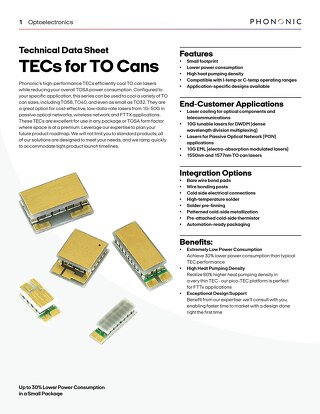Cooling in LiDAR Applications
June 18, 2019
LiDAR (light detection & ranging) applications are growing in popularity as the world becomes increasingly connected through the Internet of Things (IoT). According to Mordor Intelligence, the global LiDAR market was $1.69B in 2017, and is estimated to hit $4.5B by 2023, an impressive 12.7% CAGR.
LiDAR is a surveying method that is used to accurately measure distance from a target. Also called 3D laser scanning, it is commonly used to generate high-resolution maps of various environments, for a wide range of related applications, including:
- Autonomous vehicles, such as self-driving cars
- Industrial robots, such as those used in industrial automation or agriculture
- Mapping & surveying, as LiDAR can be easily integrated with GIS (geographic information systems)
- Atmospheric & meteorological measurement
- Military & law enforcement, such as speed guns and CSI scans
- Mining, for volume calculations and obstacle detection
- Drones, for obstacle detection
- Aerospace & transportation
- Gaming & simulations
- Renewable energy, such as measuring wind speed to automatically adjust the blades of a wind farm in order to increase the energy output
A LiDAR device has two light requirements. First, it needs a light source, typically a near-infrared (NIR) laser in the 900nm to 1600nm wavelength range, to emit light at a target. Second, a LiDAR device also needs a detector to read the light returned from the target, which will measure distance, heading, etc. This returned light is often reflected via backscattering rather than pure reflections such as in a mirror.
Different LiDAR implementations use different light scattering methods. The distance from the LiDAR sensor to the target is determined by measuring the time-of-flight (ToF) of the send and return trip of the light from the sensor to the target. Since light always travels at, well, the speed of light, knowing both velocity and time makes calculating distance fairly straightforward.
The laser light source needs to have relatively high optical power since the laser pulse will have to reflect (often diffusely) off objects of various reflectivities. Materials like pavement or rubber in car tires typically have very low reflectivity (<5%). The laser light source itself can be solid state, typically a compound semiconductor laser diode is used as the light source.
Other components within the LiDAR device include sensors (e.g., a photodetector or photomultiplier) and beam-steering optics that scan the light beam in two dimensions, which, when combined with the distance data at each point, creates the three-dimensional point cloud. The beam-steering mechanism can use a set of mirrors that adjust their reflection angles to raster, but there are also so-called “solid-state” LiDAR scanning approaches that require no moving parts, such as flash LiDAR, phased arrays, or even MEMS (microelectromechanical systems)-based steering approaches.
Since these systems are creating a lot of critical information at a rapid rate, there are electronics to compute and process the dataset, and potentially positioning and navigation systems on board as well when used in a mobile platform like an autonomous car, such as a GIS and IMU (inertial measurement unit).
Cooling LiDAR Components
The challenge, as with any laser light-generating device, is how to cool LiDAR components to maintain peak performance in a broad range of applications and operating environments.
Light Source
As the laser operates to produce light, it also generates heat, which can shift the laser’s wavelength if the laser chip is not properly cooled. Exactly how critical this is depends on the type of laser employed and the nature of its application.
Temperature and wavelength stability is especially challenging in automotive components, because the required operating temperature range is quite large (up to 125°C), which can lead to an unacceptable amount of wavelength drift of the light source. Conversely, for VCSELs (vertical-cavity surface-emitting lasers), this may be less critical, since their emission wavelengths tend to be more stable against temperature fluctuations as compared to edge emitters.
Pulse width & modulation frequency stability is another concern. Finally, the overall reliability of the light source can be improved with proper cooling to a lower operating temperature.
In coherent LiDAR schemes, which measure changes in phase of directed light on the detector side of the device, proper thermoelectric cooling is critical to provide tight control over wavelength and ensure proper detection of phase changes.
Detector
Proper cooling leads to increased sensitivity for PIN detectors due to lower dark current and higher signal-to-noise ratio. Also, active cooling with can lead to a larger stable operating temperature range for APDs (avalanche photodiode). The operating voltage of APDs is highly dependent on temperature. The cooling and temperature stability provided by thermoelectric coolers (TECs) can ensure stable detection even in the most demanding environments.
Enabling New Applications
Thermoelectric cooling for LiDAR devices also opens the door to new functionality where wavelength control is critical. ToF of the source light pulse is typically used to measure range, but wavelength shift can also be measured in a doppler effect detection scheme to sense velocity data in addition to range. A temperature-stable LiDAR can also enable applications where multiple laser wavelengths are used to deduce new information critical to ensuring safe operation. And compact beam-steering mechanisms — E-O/MEMS (electro-optical/MEMS). Beam steering enables small, aesthetically pleasing LiDAR sensors for use in passenger cars and may require active cooling to maximize performance.
LiDAR is known for precision and accuracy, but demanding applications like autonomous vehicles require absolute, consistent performance and reliability over a wide ambient temperature range to ensure the safety of passengers, other motorists and bystanders. Active cooling provided by a TEC will maximize performance and can play a key role in ensuring safety, while also minimizing component cost to keep your solution competitive in autonomous vehicle applications. Learn more about designing TECs for the perfect blend of cost and performance by reading our Design Guide.









